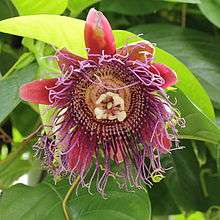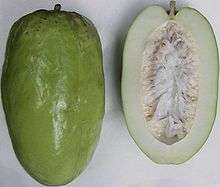Giant granadilla
| Passiflora quadrangularis | |
|---|---|
 | |
| Flowers | |
 | |
| Full and longitudinally-cut badeas | |
| Scientific classification | |
| Kingdom: | Plantae |
| (unranked): | Angiosperms |
| (unranked): | Eudicots |
| (unranked): | Rosids |
| Order: | Malpighiales |
| Family: | Passifloraceae |
| Genus: | Passiflora |
| Subgenus: | Passiflora |
| Species: | P. quadrangularis |
| Binomial name | |
| Passiflora quadrangularis L.[1] | |
The giant granadilla, barbadine (Trinidad), grenadine (Haiti), giant tumbo or badea (Spanish pronunciation: [baˈðe.a]), ටං ටිං ([ tʌŋ tʌIŋ]), Passiflora quadrangularis, produces the largest fruit any species within the genus Passiflora.[2] It is a perennial native to the Neotropics, having smooth, cordate, ovate or acuminate leaves; petioles bearing from 4 to 6 glands; an emetic and narcotic root; scented flowers; and a large, oblong fruit, containing numerous seeds, embedded in a subacid edible pulp.
The badea is sometimes grown in greenhouses. The fruits of several other species of Passiflora are eaten. P. laurifolia is the water lemon and P. maliformis the sweet calabash of the West Indies.
The fruit juice of the badea is used as a beverage.
A tea is made from the leaves which is used for high blood pressure and diabetes. A drink and ice-cream are made from the fruit.[3]
See also
- Passiflora maliformis (Sweet calabash)
- Passiflora laurifolia (Water lemon)
- Passiflora foetida (Wild water lemon or Stinking passion flower)
References
- ↑ "Taxon: Passiflora quadrangularis L.". Germplasm Resources Information Network. United States Department of Agriculture. 2007-06-25. Retrieved 2013-01-30.
- ↑ Boning, Charles R. (2006). Florida's Best Fruiting Plants: Natiive and Exotic Trees, Shrubs, and Vines. Sarasota, Florida: Pineapple Press, Inc. p. 169.
- ↑ Mendes (1986), p. 10.
 This article incorporates text from a publication now in the public domain: Chisholm, Hugh, ed. (1911). "article name needed". Encyclopædia Britannica (11th ed.). Cambridge University Press.
This article incorporates text from a publication now in the public domain: Chisholm, Hugh, ed. (1911). "article name needed". Encyclopædia Britannica (11th ed.). Cambridge University Press.- Mendes, John. (1986). Cote ce Cote la: Trinidad & Tobago Dictionary. Arima, Trinidad.
External links
 Media related to Passiflora quadrangularis at Wikimedia Commons
Media related to Passiflora quadrangularis at Wikimedia Commons Data related to Passiflora quadrangularis at Wikispecies
Data related to Passiflora quadrangularis at Wikispecies